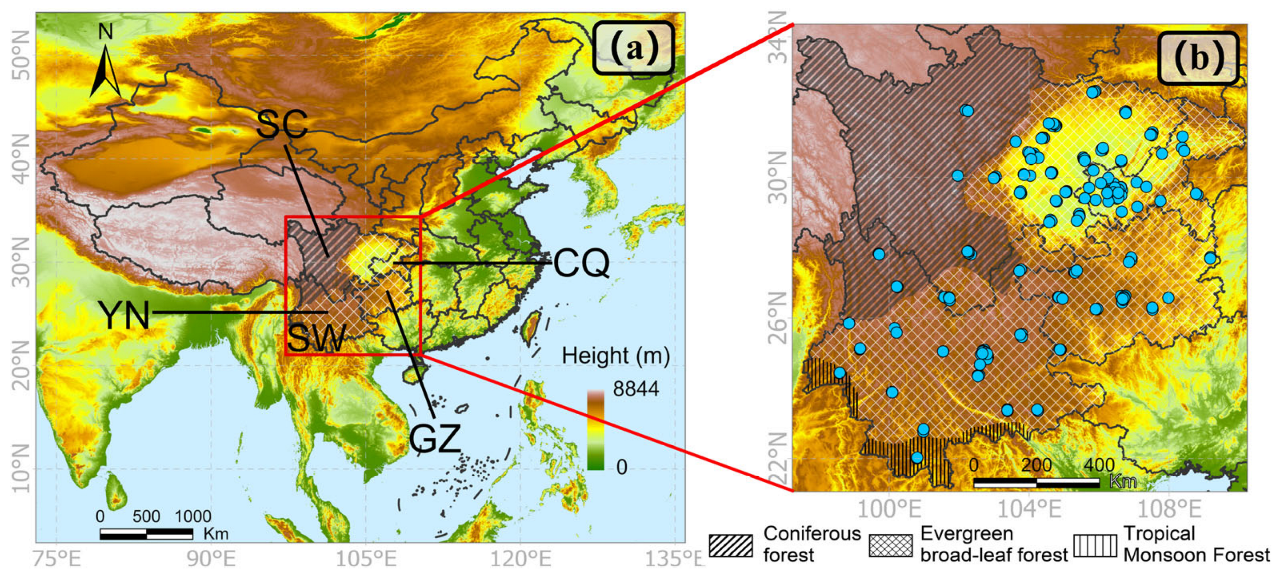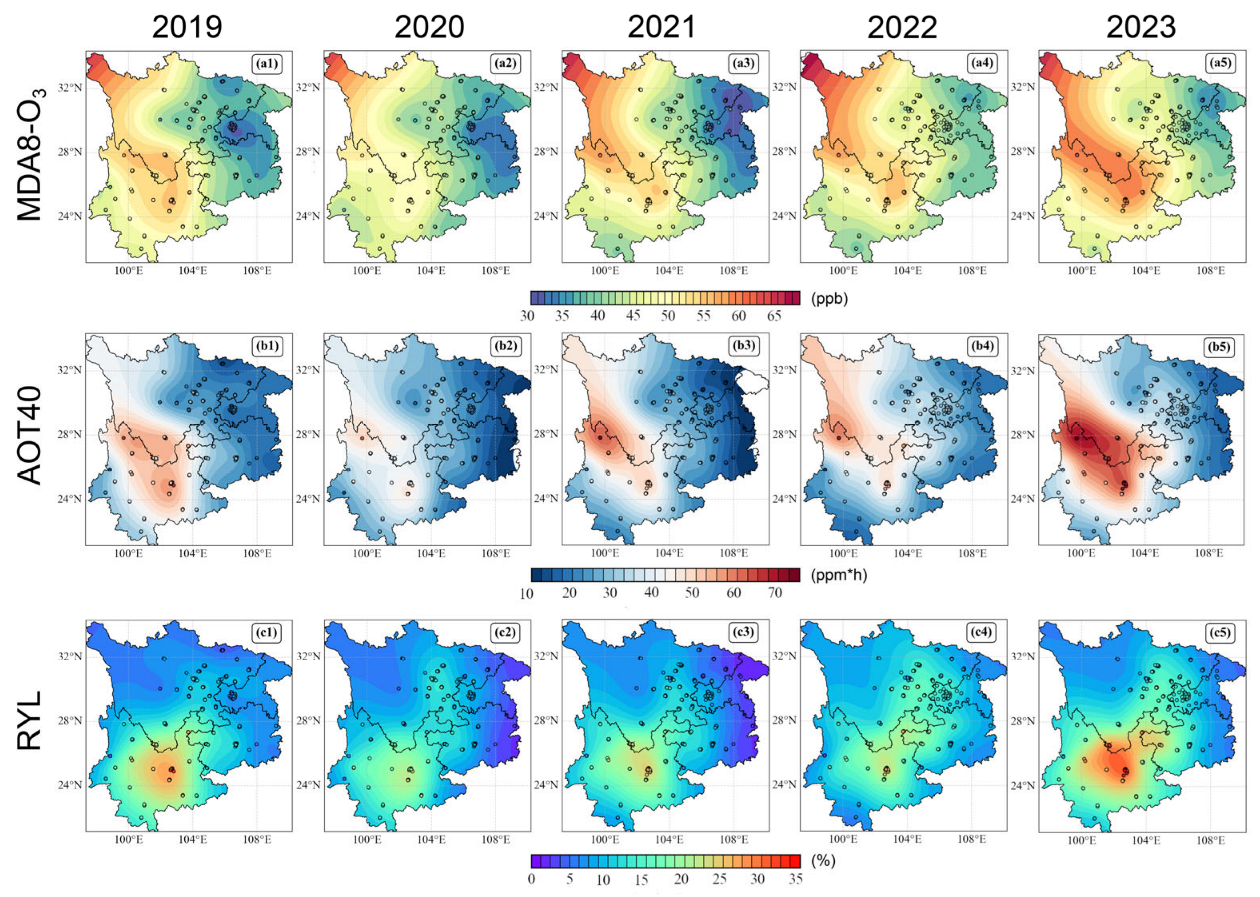Quantifying Ozone-Driven Forest Losses in Southwestern China (2019–2023)
Abstract
1. Introduction
2. Materials and Methods
2.1. O3 Monitoring Data and Forest Type Distribution
2.2. O3 Metrics
2.2.1. MDA8-O3
2.2.2. MDA8-O3 Anomaly
2.2.3. AOT40
2.3. Loss Metrics
2.3.1. Relative Yield Loss (RYL) and Exposure–Response Function
2.3.2. Economic Losses (ECL)
2.4. Cartographic Analysis Methodology
3. Results and Discussion
3.1. Distributions of O3 Metrics and RYLs
3.1.1. Spatial and Temporal Characteristics
3.1.2. O3 Monitoring Heterogeneity Effects on Estimation
3.2. Trends in O3 Metrics, RYL, and ECL
3.2.1. Trends in MDA8-O3 and MDA8-O3 Anomalies
3.2.2. Trends in ATO40, RYLs, and ECLs
3.3. Limitations and Implications
3.3.1. Exposure–Response Function
3.3.2. Limitations of Single-Factor O3 Impact Assessment and Period Duration
3.3.3. Comparison Between Forests and Crops in Terms of Yield and Economic Losses
4. Conclusions
Author Contributions
Funding
Institutional Review Board Statement
Informed Consent Statement
Data Availability Statement
Conflicts of Interest
References
- Monks, P.S.; Archibald, A.T.; Colette, A.; Cooper, O.; Coyle, M.; Derwent, R.; Fowler, D.; Granier, C.; Law, K.S.; Mills, G.E.; et al. Tropospheric ozone and its precursors from the urban to the global scale from air quality to short-lived climate forcer. Atmos. Chem. Phys. 2015, 15, 8889–8973. [Google Scholar] [CrossRef]
- Wang, Y.; Zhao, Y.; Liu, Y.; Jiang, Y.; Zheng, B.; Xing, J.; Liu, Y.; Wang, S.; Nielsen, C.P. Sustained emission reductions have restrained the ozone pollution over China. Nat. Geosci. 2023, 16, 967–974. [Google Scholar] [CrossRef]
- Mao, J.; Tai, A.P.K.; Yung, D.H.Y.; Yuan, T.; Chau, K.T.; Feng, Z. Multidecadal ozone trends in China and implications for human health and crop yields: A hybrid approach combining a chemical transport model and machine learning. Atmos. Chem. Phys. 2024, 24, 345–366. [Google Scholar] [CrossRef]
- Yang, Z.; Li, Z.; Cheng, F.; Lv, Q.; Li, K.; Zhang, T.; Zhou, Y.; Zhao, B.; Xue, W.; Wei, J. Two-decade surface ozone (O3) pollution in China: Enhanced fine-scale estimations and environmental health implications. Remote Sens. Environ. 2025, 317, 114459. [Google Scholar] [CrossRef]
- Wu, K.; Wang, Y.; Qiao, Y.; Liu, Y.; Wang, S.; Yang, X.; Wang, H.; Lu, Y.; Zhang, X.; Lei, Y. Drivers of 2013–2020 ozone trends in the Sichuan Basin, China: Impacts of meteorology and precursor emission changes. Environ. Pollut. 2022, 300, 118914. [Google Scholar] [CrossRef] [PubMed]
- Chen, Y.; Han, H.; Zhang, M.; Zhao, Y.; Huang, Y.; Zhou, M.; Wang, C.; He, G.; Huang, R.; Luo, B.; et al. Trends and Variability of Ozone Pollution over the Mountain-Basin Areas in Sichuan Province during 2013–2020: Synoptic Impacts and Formation Regimes. Atmosphere 2021, 12, 1557. [Google Scholar] [CrossRef]
- Shi, J.; Wang, Z.; Zhao, C.; Han, X.; Wang, J.; Yang, X.; Xie, H.; Zhao, P.; Ning, P. Characteristics and Causes of Ozone Pollution in 16 Cities of Yunnan Plateau. Atmosphere 2022, 13, 1177. [Google Scholar] [CrossRef]
- Wittig, V.E.; Ainsworth, E.A.; Naidu, S.L.; Karnosky, D.F.; Long, S.P. Quantifying the impact of current and future tropospheric ozone on tree biomass, growth, physiology and biochemistry: A quantitative meta-analysis. Glob. Change Biol. 2009, 15, 396–424. [Google Scholar] [CrossRef]
- Peng, J.; Shang, B.; Xu, Y.; Feng, Z.; Pleijel, H.; Calatayud, V. Ozone exposure- and flux-yield response relationships for maize. Environ. Pollut. 2019, 252 Pt A, 1–7. [Google Scholar] [CrossRef]
- Zhao, H.; Zheng, Y.; Zhang, Y.; Li, T. Evaluating the effects of surface O3 on three main food crops across China during 2015–2018. Environ. Pollut. 2020, 258, 113794. [Google Scholar] [CrossRef]
- Agathokleous, E.; Saitanis, C.J.; Agathokleous, S.; Savvides, C.; Calatayud, V.; Sicard, P. isoAOT40: An improved ozone exposure index based on the Annual Ozone Spectrum Profile (AO3SP). J. For. Res. 2022, 33, 1949–1955. [Google Scholar] [CrossRef]
- Li, S.; Leakey, A.D.B.; Moller, C.A.; Montes, C.M.; Sacks, E.J.; Lee, D.; Ainsworth, E.A. Similar photosynthetic but different yield responses of C3 and C4 crops to elevated O3. Proc. Natl. Acad. Sci. USA 2023, 120, e2313591120. [Google Scholar] [CrossRef] [PubMed]
- Zhao, H.; Zhang, Y.; Qi, Q.; Zhang, H. Evaluating the Impacts of Ground-Level O3 on Crops in China. Curr. Pollut. Rep. 2021, 7, 565–578. [Google Scholar] [CrossRef]
- Feng, Z.; De Marco, A.; Anav, A.; Gualtieri, M.; Sicard, P.; Tian, H.; Fornasier, F.; Tao, F.; Guo, A.; Paoletti, E. Economic losses due to ozone impacts on human health, forest productivity and crop yield across China. Environ. Int. 2019, 131, 104966. [Google Scholar] [CrossRef] [PubMed]
- Wang, Q.; Huang, M.; Wang, S.; Chen, B.; Liu, Z.; Wang, Z.; Chen, S.; Li, H.; Zhu, T.; Li, D.; et al. Evaluation of the impacts of ozone on the vegetation productivity of woodland and grassland ecosystems in China. Ecol. Model. 2023, 483, 110426. [Google Scholar] [CrossRef]
- Sorrentino, B.; Anav, A.; Calatayud, V.; Collalti, A.; Sicard, P.; Leca, S.; Fornasier, F.; Paoletti, E.; De Marco, A. Inconsistency between process-based model and dose-response function in estimating biomass losses in Northern Hemisphere due to elevated O3. Environ. Pollut. 2025, 364 Pt 2, 125379. [Google Scholar] [CrossRef]
- Piao, S.; Wang, X.; Park, T.; Chen, C.; Lian, X.; He, Y.; Bjerke, J.W.; Chen, A.; Ciais, P.; Tømmervik, H.; et al. Characteristics, drivers and feedbacks of global greening. Nat. Rev. Earth Environ. 2019, 1, 14–27. [Google Scholar] [CrossRef]
- Qiao, X.; Wang, P.; Zhang, J.; Zhang, H.L.; Tang, Y.; Hu, J.L.; Ying, Q. Spatial-temporal variations and source contributions to forest ozone exposure in China. Sci. Total Environ. 2019, 674, 189–199. [Google Scholar] [CrossRef]
- Wang, H.; Zhang, Y.; Luo, Z.; Wang, Y.; Dai, Q.; Bi, X.; Wu, J.; Feng, Y. Spatial-temporal Variation and DriVing Factors of Ozone in China from 2019 to 2021Based on EOF Technique and KZ Filter. Environ. Sci. 2023, 44, 1811–1820. [Google Scholar]
- Zhou, B. Resources Dynamics and Restoration Strategy of Natural Forests in Southwest China. Ph.D. Thesis, Chinese Academy of Forestry, Beijing, China, 2011. [Google Scholar]
- Wang, H.; Zeng, X.; Kou, W.; Ma, M.; Gao, Y. Characteristics of ozone pollution and effects of biogenic emissions based on numerical modeling in the Yangtze River Delta. J. Mar. Meteorol. 2022, 42, 67–76. [Google Scholar]
- Lu, X.; Zhang, L.; Wang, X.; Gao, M.; Li, K.; Zhang, Y.; Yue, X.; Zhang, Y. Rapid Increases in Warm-Season Surface Ozone and Resulting Health Impact in China Since 2013. Environ. Sci. Technol. Lett. 2020, 7, 240–247. [Google Scholar] [CrossRef]
- Lefohn, A.S.; Malley, C.S.; Smith, L.; Wells, B.; Hazucha, M.; Simon, H.; Naik, V.; Mills, G.; Schultz, M.G.; Paoletti, E.; et al. Tropospheric ozone assessment report: Global ozone metrics for climate change, human health, and crop/ecosystem research. Elem. Sci. Anthr. 2018, 6, 27. [Google Scholar] [CrossRef]
- Marco, A.D.; Anav, A.; Sicard, P.; Feng, Z.; Paoletti, E. High spatial resolution ozone risk-assessment for Asian forests. Environ. Res. Lett. 2020, 15, 104095. [Google Scholar] [CrossRef]
- Ren, X.; Shang, B.; Feng, Z.; Calatayud, V. Yield and economic losses of winter wheat and rice due to ozone in the Yangtze River Delta during 2014-2019. Sci. Total Environ. 2020, 745, 140847. [Google Scholar] [CrossRef]
- Buker, P.; Feng, Z.; Uddling, J.; Briolat, A.; Alonso, R.; Braun, S.; Elvira, S.; Gerosa, G.; Karlsson, P.E.; Le Thiec, D.; et al. New flux based dose-response relationships for ozone for European forest tree species. Environ. Pollut. 2015, 206, 163–174. [Google Scholar] [CrossRef]
- Feng, Z.; Peng, J. Relationship Between RelatiVe Crop Yield/Woody Plant Biomass and Ground-level OZone Pollution in China. Environ. Int. 2021, 42, 3084–3090. [Google Scholar]
- Majdisova, Z.; Skala, V. Radial basis function approximations: Comparison and applications. Appl. Math. Model. 2017, 51, 728–743. [Google Scholar] [CrossRef]
- Yue, X.; Lei, Y.; Zhou, H.; Liu, Z.; Letu, H.; Cai, Z.; Lin, J.; Jiang, Z.; Liao, H. Changes of anthropogenic carbon emissions and air pollutants during the COVID-19 epidemic in China. Trans. Atmos. Sci. 2020, 43, 265–274. [Google Scholar]
- Bauwens, M.; Compernolle, S.; Stavrakou, T.; Muller, J.F.; van Gent, J.; Eskes, H.; Levelt, P.F.; van der A, R.; Veefkind, J.P.; Vlietinck, J.; et al. Impact of Coronavirus Outbreak on NO2 Pollution Assessed Using TROPOMI and OMI Observations. Geophys. Res. Lett. 2020, 47, e2020GL087978. [Google Scholar] [CrossRef]
- Wang, W.; Parrish, D.D.; Wang, S.; Bao, F.; Ni, R.; Li, X.; Yang, S.; Wang, H.; Cheng, Y.; Su, H. Long-term trend of ozone pollution in China during 2014–2020: Distinct seasonal and spatial characteristics and ozone sensitivity. Atmos. Chem. Phys. 2022, 22, 8935–8949. [Google Scholar] [CrossRef]
- Kang, M.; Zhang, J.; Zhang, H.; Ying, Q. On the Relevancy of Observed Ozone Increase during COVID-19 Lockdown to Summertime Ozone and PM2.5 Control Policies in China. Environ. Sci. Technol. Lett. 2021, 8, 289–294. [Google Scholar] [CrossRef]
- Miyazaki, K.; Bowman, K.; Sekiya, T.; Takigawa, M.; Neu, J.L.; Sudo, K.; Osterman, G.; Eskes, H. Global tropospheric ozone responses to reduced NOx emissions linked to the COVID-19 worldwide lockdowns. Sci. Adv. 2021, 7, eabf7460. [Google Scholar] [CrossRef]
- Peralta, O.; Ortínez-Alvarez, A.; Torres-Jardón, R.; Suárez-Lastra, M.; Castro, T.; Ruíz-Suárez, L.G. Ozone over Mexico City during the COVID-19 pandemic. Sci. Total Environ. 2021, 761, 143183. [Google Scholar] [CrossRef]
- Sicard, P.; De Marco, A.; Agathokleous, E.; Feng, Z.; Xu, X.; Paoletti, E.; Rodriguez, J.J.D.; Calatayud, V. Amplified ozone pollution in cities during the COVID-19 lockdown. Sci. Total Environ. 2020, 735, 139542. [Google Scholar] [CrossRef]
- Luo, Y.; Tan, X.; Zou, X.; Rao, X.; Lin, Y.; Shen, W. Understory Plant Diversity Characteristics and Influencing Factors of Four Common Plantations in South China. J. Trop. Subtrop. Bot. 2022, 30, 1–10. [Google Scholar]
- Li, M.; Liu, P.; Wen, Q.; Huang, Y.; Liu, J. Biomass and Its Allocation Characteristics of Betula alnoides Plantations at Different Stand Ages. J. West China For. Sci. 2024, 53, 91–98. [Google Scholar]
- Balla, A.; Silini, A.; Cherif-Silini, H.; Chenari Bouket, A.; Moser, W.K.; Nowakowska, J.A.; Oszako, T.; Benia, F.; Belbahri, L. The Threat of Pests and Pathogens and the Potential for Biological Control in Forest Ecosystems. Forests 2021, 12, 1579. [Google Scholar] [CrossRef]
- Trogisch, S.; Liu, X.; Rutten, G.; Xue, K.; Bauhus, J.; Brose, U.; Bu, W.; Cesarz, S.; Chesters, D.; Connolly, J.; et al. The significance of tree-tree interactions for forest ecosystem functioning. Basic Appl. Ecol. 2021, 55, 33–52. [Google Scholar] [CrossRef]
- Hou, Y.; Li, X.; Hu, Y.; Lu, X.; Ma, Y.; Li, W.; Lü, X.; Li, Z.; Bai, Y.; Wang, C.; et al. Drought weakens the positive effect of plant diversity on community biomass. J. Plant Ecol. 2024, 17, rtae059. [Google Scholar] [CrossRef]
- Wang, Z.; Chen, W.; Piao, J.; Cai, Q.; Chen, S.; Xue, X.; Ma, T. Synergistic effects of high atmospheric and soil dryness on record-breaking decreases in vegetation productivity over Southwest China in 2023. npj Clim. Atmos. Sci. 2025, 8, 6. [Google Scholar] [CrossRef]
- Feng, Z.; Xu, Y.; Kobayashi, K.; Dai, L.; Zhang, T.; Agathokleous, E.; Calatayud, V.; Paoletti, E.; Mukherjee, A.; Agrawal, M.; et al. Ozone pollution threatens the production of major staple crops in East Asia. Nat. Food 2022, 3, 47–56. [Google Scholar] [CrossRef] [PubMed]




Disclaimer/Publisher’s Note: The statements, opinions and data contained in all publications are solely those of the individual author(s) and contributor(s) and not of MDPI and/or the editor(s). MDPI and/or the editor(s) disclaim responsibility for any injury to people or property resulting from any ideas, methods, instructions or products referred to in the content. |
© 2025 by the authors. Licensee MDPI, Basel, Switzerland. This article is an open access article distributed under the terms and conditions of the Creative Commons Attribution (CC BY) license (https://creativecommons.org/licenses/by/4.0/).
Share and Cite
Xia, Q.; Zhang, J.; Lv, Z.; Wu, D.; Tang, X.; Liu, H. Quantifying Ozone-Driven Forest Losses in Southwestern China (2019–2023). Atmosphere 2025, 16, 927. https://doi.org/10.3390/atmos16080927
Xia Q, Zhang J, Lv Z, Wu D, Tang X, Liu H. Quantifying Ozone-Driven Forest Losses in Southwestern China (2019–2023). Atmosphere. 2025; 16(8):927. https://doi.org/10.3390/atmos16080927
Chicago/Turabian StyleXia, Qibing, Jingwei Zhang, Zongxin Lv, Duojun Wu, Xiao Tang, and Huizhi Liu. 2025. "Quantifying Ozone-Driven Forest Losses in Southwestern China (2019–2023)" Atmosphere 16, no. 8: 927. https://doi.org/10.3390/atmos16080927
APA StyleXia, Q., Zhang, J., Lv, Z., Wu, D., Tang, X., & Liu, H. (2025). Quantifying Ozone-Driven Forest Losses in Southwestern China (2019–2023). Atmosphere, 16(8), 927. https://doi.org/10.3390/atmos16080927






